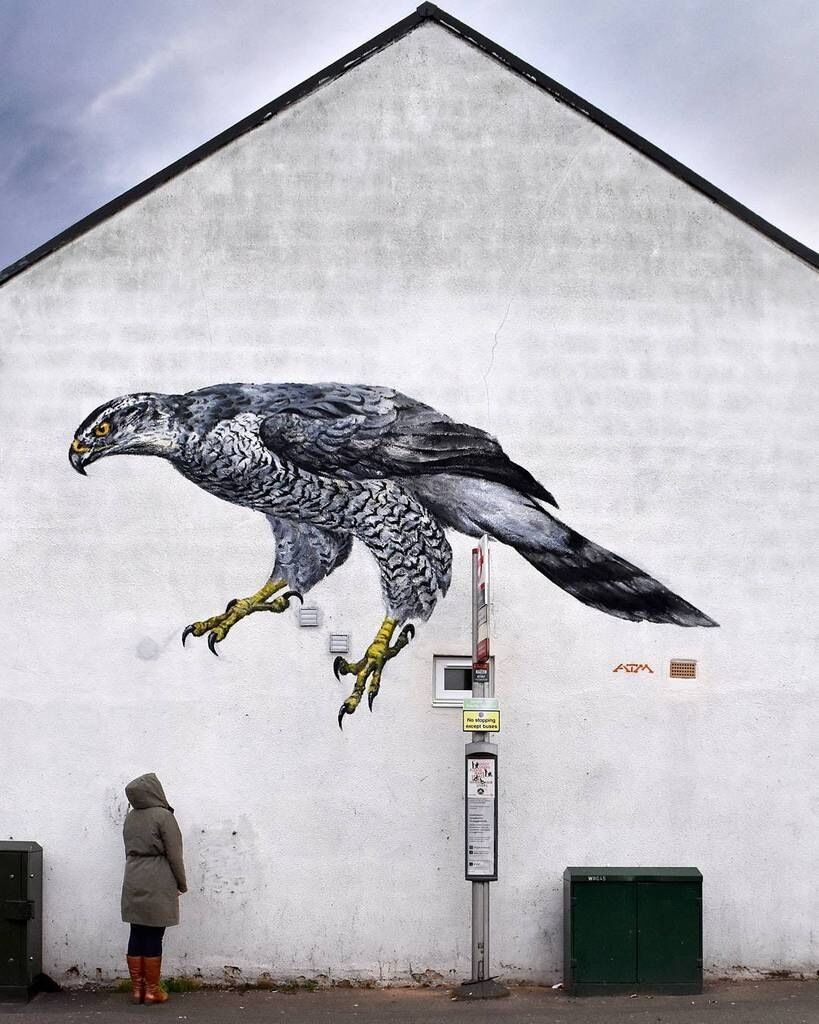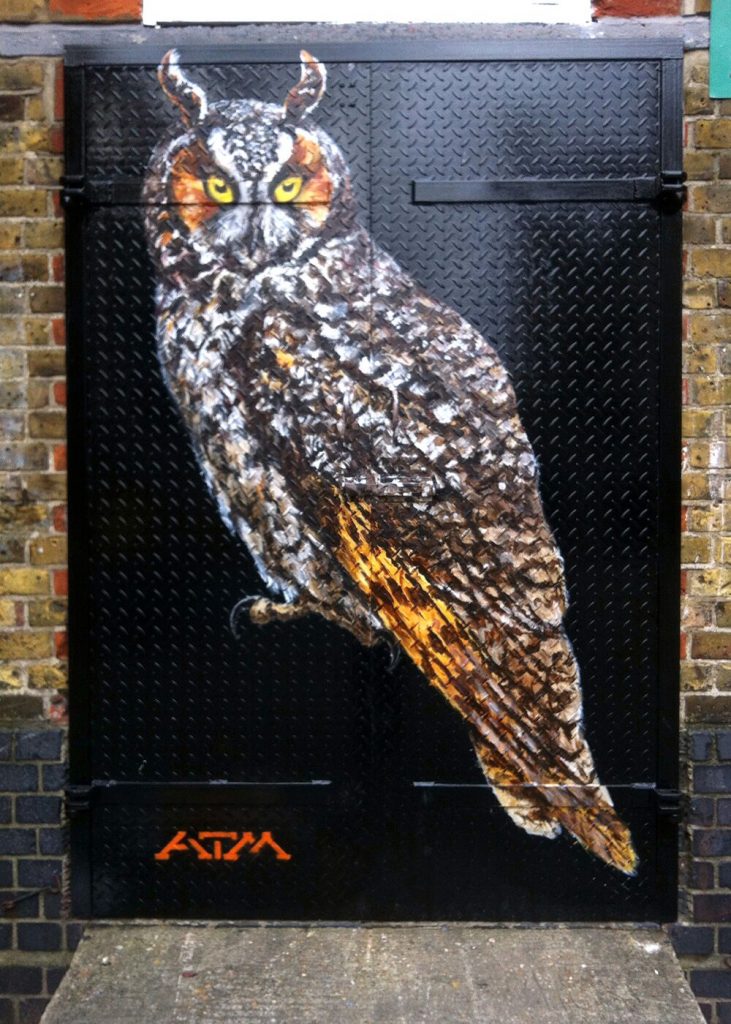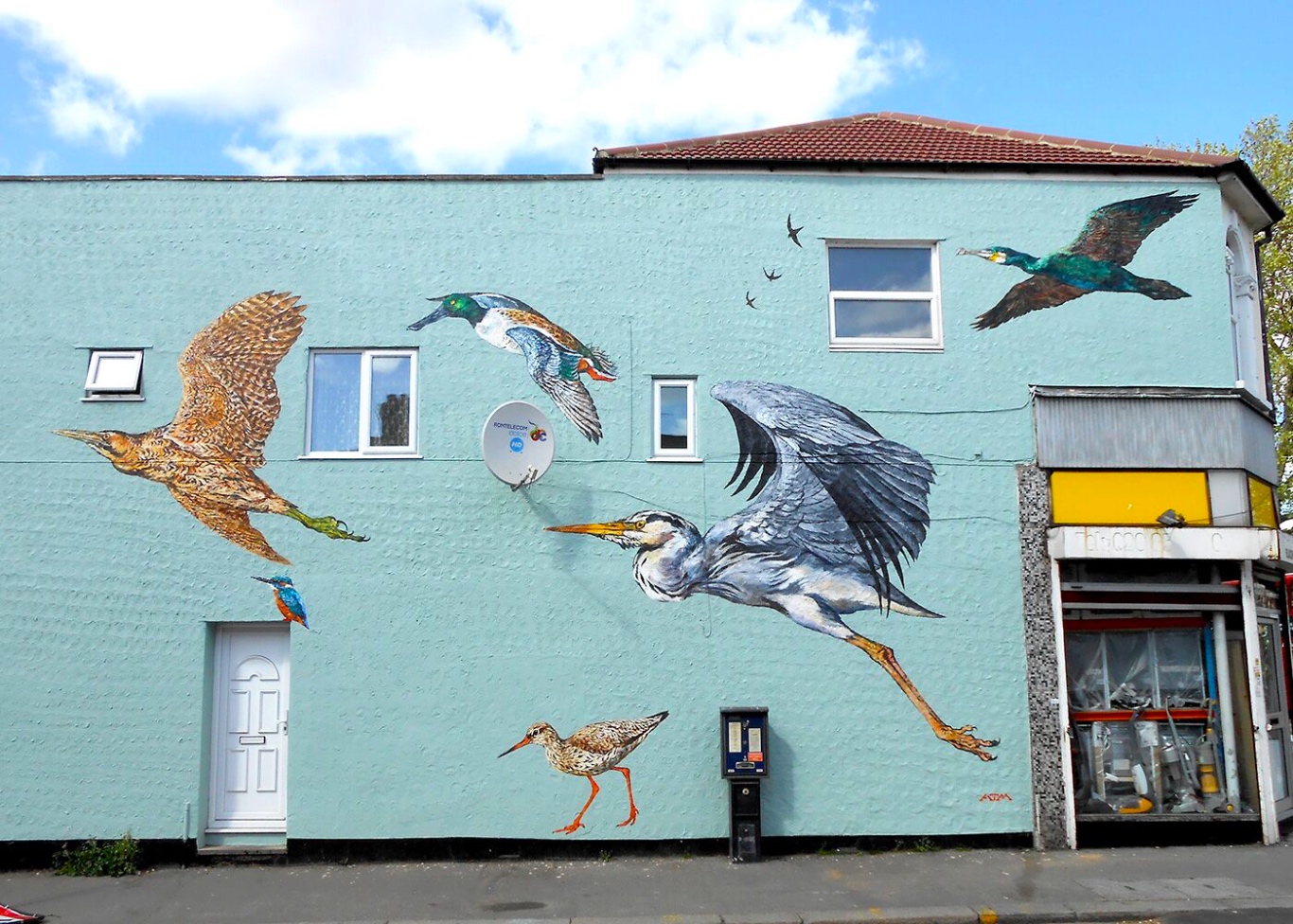You may have spotted barn owls, goshawks and bitterns across the capital: after all, street artist ATM is on a mission to bring back the birds disappearing from our skies. He chooses those that have a connection to the place, or might have lived there in the past – a snipe on Bollo Bridge Road in Acton, for instance, where the Bollo river once flowed.
At the new Walthamstow Wetlands, which opened last year and offers a haven for birds, ATM was invited to contribute a mural celebrating the birds that pass through. The resulting piece on Coppermill Lane is colourful and elegant, but also educational. And, as art continues to play a central role in educating communities about environmental issues, ATM’s rare and endangered British birds make an important point.
Where did you grow up?
In Rochdale in the north-west. I had access to lots of ‘neglected’ places: rough ground, empty fields, overgrown blackberry bushes behind derelict garages, slag heaps, little ponds and streams full of frogs and sticklebacks. Those places are now built over with houses, the ponds filled in by councils.
Did you go to art college?
I went to three: a foundation year at Rochdale, with maverick teachers and an openness to different styles and approaches; they weren’t prescriptive at all. Then I did a year at Cheltenham, which was a nightmare: they had very definite ideas about what painting should look like – a kind of half-baked British post-impressionism – which I found very boring and parochial. I loved Renaissance classical painting – the works of Titian for example – and I wanted to learn those techniques but we were force-fed. I got expelled at the end of my first year. I did three years at Sheffield after that, where they were much more tolerant of my ambitions and let me get on with my own thing.
LOCAL ADVERTISING
So when did you first start exploring street art?
Initially it was a way to show my disgust at the wars in Afghanistan and Iraq. I went on all the anti-war marches, which had no effect, so I turned to graffiti. I also used stencils to react against the commercialisation of everything, including street art. I’ve been working in London on and off since I left college, painting on canvas as well as doing street art. London has got much busier over that time and there are huge building developments going on all over the city, without concern for humane civic spaces or the natural environment.

What do you think is the role of street art?
It has the potential to counter the crass advertising selling the consumerist lifestyle that plagues our cities. I’m surprised that more street art in London isn’t overtly political or campaigning. So much of it seems to embrace the least challenging aspects of popular culture, which in effect exist to distract us from what is really going on.
Which street artists do you admire then?
Banksy, of course, as he tackles political questions with wit. I’m also a big fan of Blek le Rat, who started the whole idea of stencils in public places, and actually inspired Banksy. Carrie Reichardt, a member of the Craftivism movement, which combines anti-capitalist, environmental activism with craft, does very interesting work too.
Have you always been interested in nature?
I was obsessed with birds, and drawing them, when I was younger. When I went to college I pursued my other interests but was always very aware of the natural world. It’s only in recent years that I’ve found a way to combine my love of painting, birds and conservation.
Do you have a favourite bird?
I’ll say goshawk, even though it’s hard to pick a favourite. Goshawks are persecuted by gamekeepers because they take some pheasants. But they’re key to a healthy and balanced eco-system. I hope they’ll come back to London one day – you can find them in Berlin, so why not here?
How do you choose where to place your pieces?
I get offered walls or I find them. I need permission to paint my birds, as they take two to three days and I need daylight. I like unusual places – buildings in remote places or very prominent walls in bare urban spaces – as the contrast between the urban and the depiction of the natural beauty we have lost becomes more dramatic and surreal.
What has the response from local communities been like?
Overwhelmingly positive. People appreciate colour and interesting images brought into their daily environment. They are often so happy to have a painting near where they live or walk to work.

Tell us a little bit about your favourite piece.
My favourite has to be the hen harrier on a pill box on the Isle of Sheppey. They’re badly persecuted by gamekeepers on grouse moors in England, where they migrate. As I was painting, the air was full of the calls of shorebirds like oystercatchers, curlew and redshank. Painting on a defensive relic of the Second World War also says something about nature triumphing over huge political upheavals and environmental catastrophes, and I need to hold onto that idea.
More recently, I worked on a piece of a cuttlefish on the main road to the Isle of Wight ferry in Portsmouth, a collaboration with the Wildlife Trust, as part of their campaign to protect the Solent, where cuttlefish and myriad other species lay their eggs and nurse their young in the seagrass.
And finally, any advice for aspiring artists?
Work on what inspires you, and what you feel love for. You’ll need that passion to keep going through hard times; don’t be distracted by art fashions.
4 places to discover work by ATM
Walthamstow
As well as Coppermill Lane in E17, in Aubrey Road you’ll find a wagtail. While you’re in the area, do check out the street art gallery around Wood Street (and two pied wagtails in Brandon Road Car Park).
Camden
Last year, Camden Council invited well-known artists such as ATM, Gary Stranger and Sokar Unio to spruce up Ferdinand Estate in Chalk Farm. 30 murals include an owl by ATM.
Turnpike Lane
There are a few ATM pieces near Turnpike Lane tube station. You can find a lapwing on Langham Road, a bullfinch around the corner on Waldeck Road and a heron very nearby – on Langham Place.
Acton
A resident of the area, ATM has contributed several pieces here. Near South Acton station, you can find a goldfinch at Berrymede School, a snipe on Bollo Bridge Road and a barn owl on South Acton estate.


